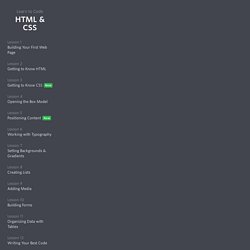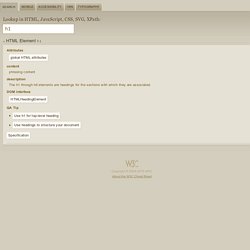

Can I use... Support tables for HTML5, CSS3, etc. HTML5 Please - Use the new and shiny responsibly. Modernizr: the feature detection library for HTML5/CSS3. Positioning Content - Learn to Code HTML. Lesson 5 One of the best things about CSS is that it gives us the ability to position content and elements on a page in nearly any imaginable way, bringing structure to our designs and helping make content more digestible.

There are a few different types of positioning within CSS, and each has its own application. In this chapter we’re going to take a look at a few different use cases—creating reusable layouts and uniquely positioning one-off elements—and describe a few ways to go about each. Positioning with Floats#floats One way to position elements on a page is with the float property. Essentially, the float property allows us to take an element, remove it from the normal flow of a page, and position it to the left or right of its parent element. When the float property is used on multiple elements at the same time, it provides the ability to create a layout by floating elements directly next to or opposite each other, as seen in multiple-column layouts. Floats in Practice Clearing Floats.
W3C cheatsheet. The encoding used for an HTML page that contains a form should support all the characters needed to enter data into that form.

This is particularly important if users are likely to enter information in multiple languages. Databases and scripts that receive data from forms on pages in multiple languages must also be able to support the characters for all those languages simultaneously. The simplest way to enable this is to use Unicode for both pages containing forms and all back-end processing and storage. In such a scenario the user can fill in data in whatever language and script they need to. You should also try to avoid making assumptions that things such as the user's name and address will follow the same formatting rules as your own.
If you are gathering information from people in more than one country, it is important to develop a strategy for addressing the different formats people will expect to be able to use. So, how do I do this? Unicorn. The W3C Markup Validation Service. C Link Checker. The W3C CSS Validation Service. C mobileOK Checker. C RDF Validation Service. Semantic data extractor - QA @ W3C. C XML Schema. If you want yours listed here, please send an announcement to xmlschema-dev.

Recent changes / news: P3P Validator. C Feed Validation Service, for Atom and RSS. The W3C QA Toolbox - Validators, checkers and other tools for Webmasters and Web Developers. Get help Stack Overflow has a great and active community focused around W3C Standards and W3C developer tools.

To ask a question to the W3C Community, we invite you to use the w3c tag. Ask a question Contribute Developers are welcome to get involved by contributing code, either to existing tools or proposed future projects. Testing, bug reports, suggestions, or help in creating good documentation are also important! You will find more information to get started in each project on their own web page. Find projects on Github Donate Good tools cost a lot to develop, support, host and maintain.
With your help, we can make the tools and validators better, faster, friendlier, and maintain a great, free service for all of the Web. Donate now. C Data Activity - Building the Web of Data. More and more Web applications provide a means of accessing data.

From simple visualizations to sophisticated interactive tools, there is a growing reliance on the availability of data which can be “big” or “small”, of diverse origin, and in different formats; it is usually published without prior coordination with other publishers — let alone with precise modeling or common vocabularies. The Data Activity recognizes and works to overcome this diversity to facilitate potentially Web-scale data integration and processing.
It does this by providing standard data exchange formats, models, tools, and guidance. The overall vision of the Data Activity is that people and organizations should be able to share data as far as possible using their existing tools and working practices but in a way that enables others to derive and add value, and to utilize it in ways that suit them. Achieving that requires a focus not just on the interoperability of data but of communities. Questions?